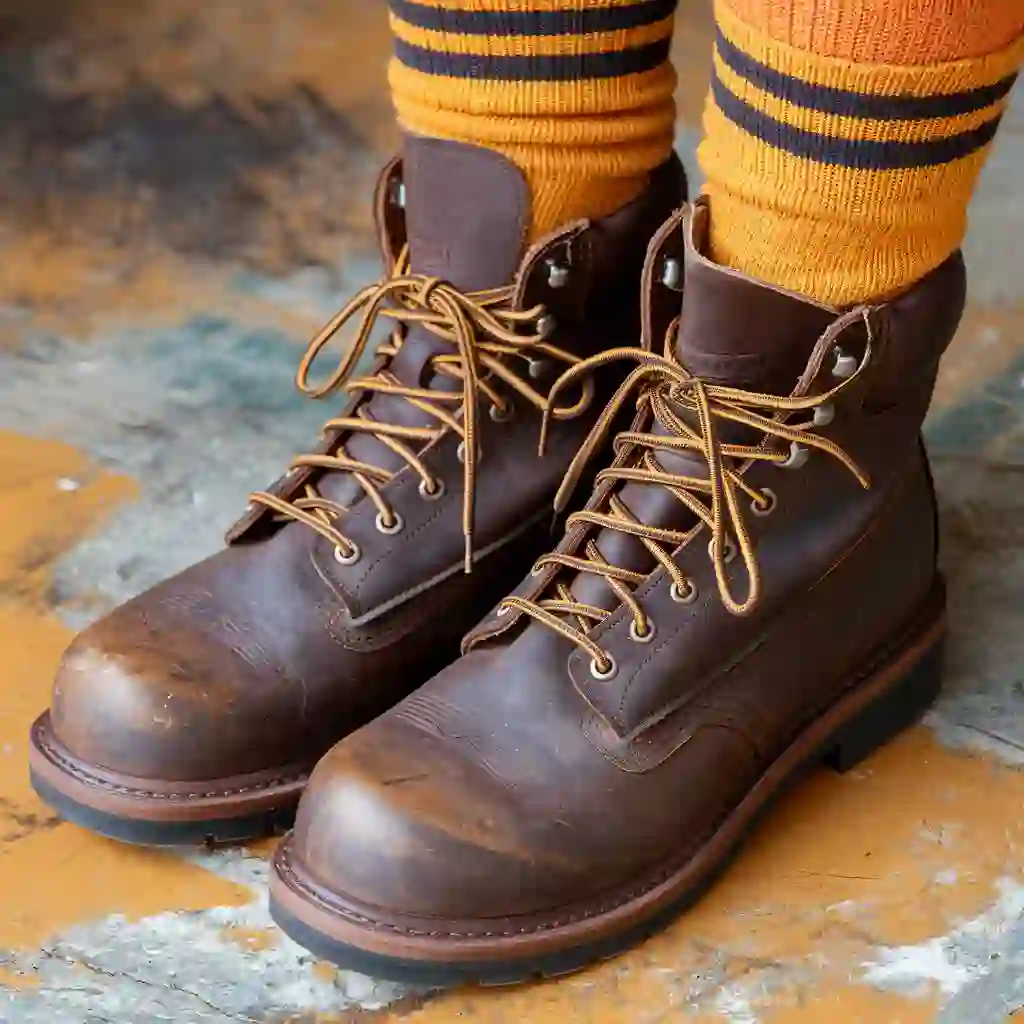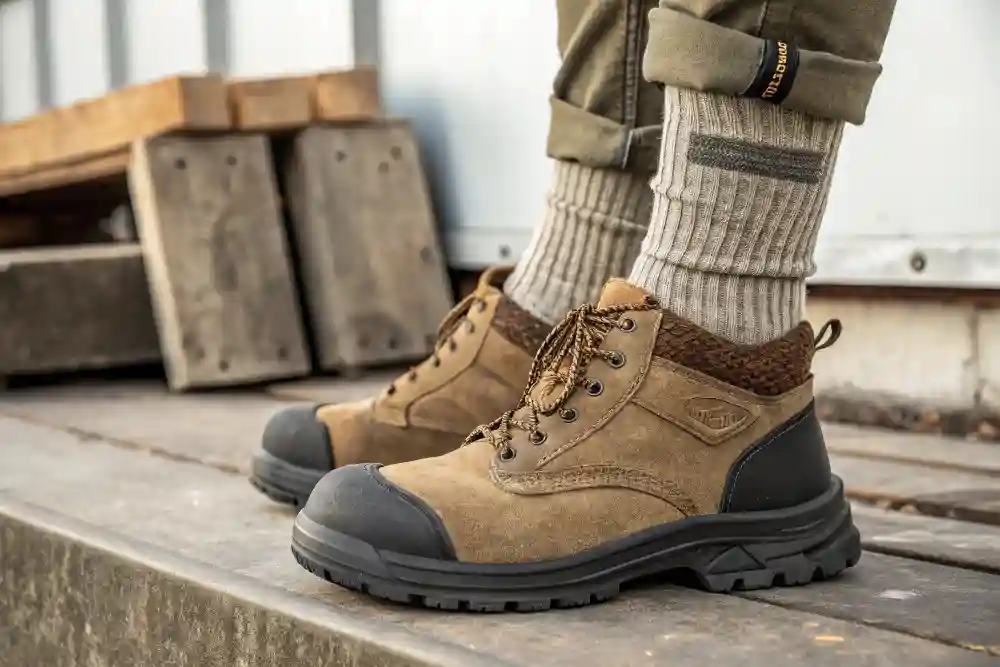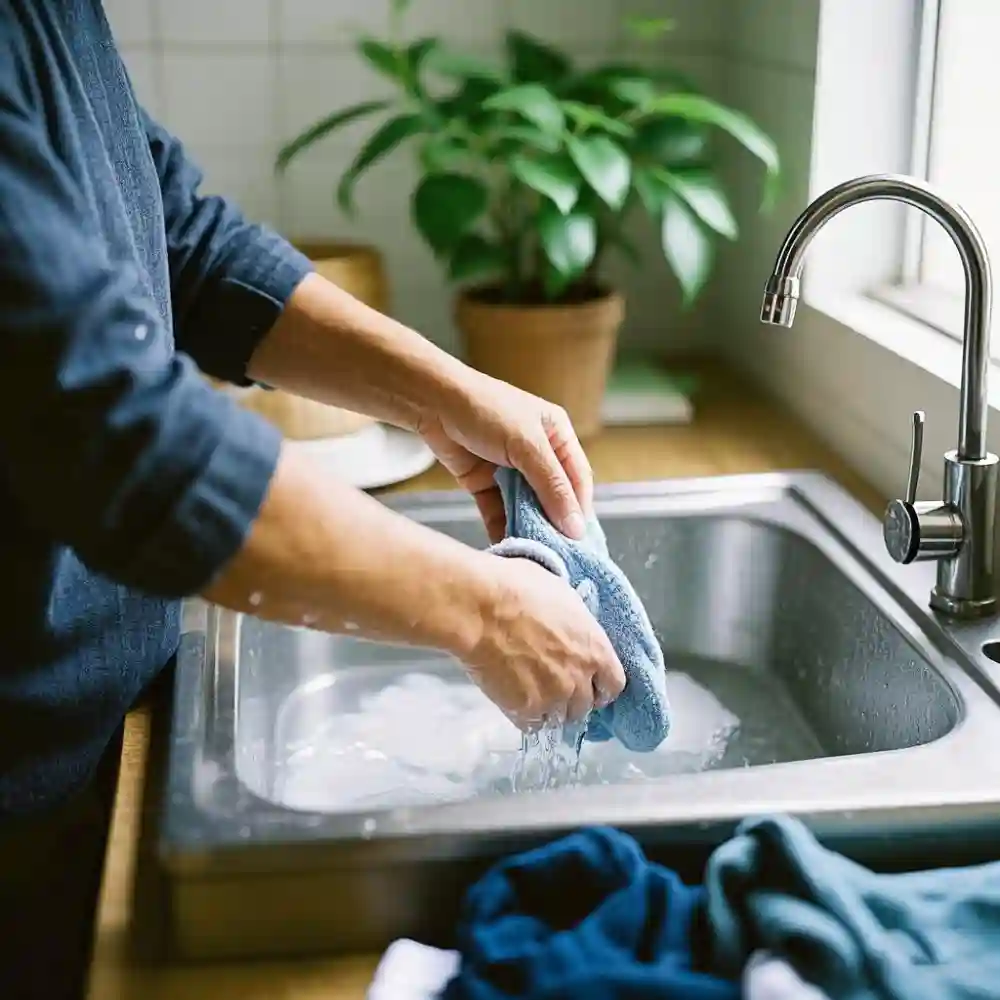Introduction: The Rising Demand for Boot Socks
The global socks market is experiencing significant growth, with projections estimating it will reach approximately USD 95.1 billion by 2030, growing at a compound annual growth rate (CAGR) of 6.8% from 2023 to 2030. Boot socks have surged to the forefront of this growth, with Google Trends showing a 180% year-over-year spike in searches as consumers prioritize durable cold-weather solutions. No longer confined to utility, these staples now merge thermal protection with runway-ready textures like ribbed merino wool and heathered cashmere blends. For brands, this isn’t just about capitalizing on a trend—it’s about dominating a segment where margins outperform basic apparel by 35%. From construction crews needing abrasion-resistant designs to urban shoppers seeking compression-lined styles, boot socks are redefining what “essential” means.

What Are Boot Socks? Definition and Core Features
Clear Definition: What Exactly Are Boot Socks?
Boot socks refer to specially designed socks intended to pair specifically with boots. Unlike regular socks, these typically feature thicker material and extended length, offering enhanced comfort, warmth, and foot protection. They’re crafted to address the unique challenges that boots present, such as friction, limited breathability, and varying weather conditions, making them a practical choice for everyday wear, outdoor activities, and fashion purposes.
Core Features of Boot Socks:
Ideal Length: Why 11 inches Matters
Most designs measure around 11 inches from heel to cuff, extending well above standard footwear openings. This length ensures coverage that protects the leg against irritation caused by direct contact with boot edges. It also helps prevent slipping and bunching, keeping feet comfortable throughout prolonged wear. Such a design is beneficial for outdoor enthusiasts, workers, or anyone seeking greater stability in rugged conditions.
Material Choices: Wool, Cotton, and Synthetic Blends
Material selection is crucial, with wool, cotton, and synthetic blends dominating the market:
- Wool (especially Merino wool) is highly favored due to its natural moisture-wicking and temperature-regulating abilities, suitable for colder environments or strenuous outdoor activities.
- Cotton provides comfort and breathability, making it suitable for everyday casual wear or moderate climates.
- Synthetic blends (like polyester or nylon) deliver durability, elasticity, and rapid moisture evaporation, ideal for sports or physically demanding activities.
Cushioning Design: Comfort in Key Areas
Strategically placed cushioning significantly improves wearing experience. Typically, cushioning appears on high-impact areas like soles and heels, reducing pressure, friction, and fatigue. At the same time, the instep area usually remains thinner to promote ventilation, enhancing overall comfort and keeping feet dry. This balanced cushioning approach provides adequate support without sacrificing breathability, catering to diverse customer needs.
Functions and Advantages of Boot Socks
Improved Comfort
Reducing Friction and Preventing Blisters
One major advantage of specialized hosiery is the ability to minimize friction. Constant rubbing between feet and footwear causes blisters, especially during extended walking or hiking. Quality hosiery includes cushioning around the heel and toe areas, significantly lowering friction. This design ensures comfort and reduces the risk of painful blisters, promoting longer wear times without discomfort.

Enhanced Arch Support and Fatigue Relief
Properly designed socks offer targeted arch support, evenly distributing pressure across the foot. This reduces fatigue and discomfort associated with prolonged standing or activity. By gently supporting arches, these socks enhance foot alignment, improving overall comfort throughout the day.
Protection and Durability
Protecting Boots from Internal Wear
Quality hosiery protects footwear interiors from premature wear. Continuous rubbing between footwear lining and bare skin or thin socks can degrade the lining over time. Thicker and durable materials form a barrier, extending footwear lifespan and maintaining their internal condition.
Preventing Foot Abrasions and Injuries
Protective materials shield feet from rough seams, stitching, and rigid edges inside footwear. Strategically placed padding and reinforced heels provide additional cushioning, reducing the risk of abrasions, soreness, and other minor injuries during regular or intensive use.
Climate Adaptability
Winter Warmth with Wool
Wool-based materials effectively trap warmth, providing essential insulation during colder months. These materials naturally regulate temperature, keeping feet warm without overheating. As a result, they are a preferred choice for winter or colder climates.
Summer Breathability and Moisture Management
Lightweight synthetic blends or breathable cotton fabrics enhance comfort during warmer months. These fabrics efficiently manage moisture, quickly drawing sweat away from the skin, ensuring dryness and preventing unpleasant odors even in hot climates.
Fashion and Style
Styling with Skirts, Shorts, or Leggings
Versatile designs make hosiery a popular fashion accessory. They can complement skirts, shorts, or leggings by adding a subtle yet stylish layer to outfits. This versatility attracts fashion-conscious consumers seeking practical but fashionable apparel.
Customizing Colors and Patterns for Market Appeal
Offering various color options and unique patterns allows brands to target different customer preferences effectively. Customized designs, such as lace trims or themed patterns, help distinguish brands in competitive markets and attract diverse consumer segments looking for personalized styles.
Main Types of Boot Socks
Types by Length:
Crew Boot Socks: Everyday Versatility
Crew-length designs extend just a few inches above standard boot openings. This style is ideal for daily wear, providing sufficient coverage without extra bulk. They pair easily with casual boots or hiking footwear, balancing style and practicality.
Over-the-Knee Boot Socks: Cold-Weather Comfort
Over-the-knee styles offer extended coverage, reaching mid-calf or higher. Designed primarily for colder weather, they effectively trap warmth and offer additional protection against harsh conditions. They pair seamlessly with tall boots, providing both fashion appeal and comfort.
Ankle Boot Socks: Ideal for Short Boots
Ankle-length styles are shorter and lighter, designed specifically for low-cut footwear. They’re ideal for casual use, offering minimal coverage while providing necessary cushioning. These socks keep feet comfortable without becoming overly bulky, making them suitable for daily wear.
Types by Function:
Compression Boot Socks: Enhance Circulation and Reduce Fatigue
Compression styles apply gentle pressure to improve blood flow, reducing swelling and discomfort during prolonged wear. Ideal for active users or those who stand frequently, these socks provide essential comfort while enhancing overall foot health.
Boot Liners: Lightweight for Moisture Control
Boot liners are thin, lightweight socks worn inside heavier footwear. Their primary function is managing moisture, keeping feet dry, and preventing odors. They enhance comfort by maintaining a dry environment and preventing irritation, especially during activities involving extended wear.

Fully Cushioned Boot Socks: Extra Protection and Warmth
Fully cushioned styles feature additional padding throughout, designed for challenging conditions or cold environments. This extra cushioning protects feet against impacts, abrasions, and cold temperatures. Suitable for heavy-duty use, these socks provide comprehensive protection and long-lasting durability.
How to Select and Match Boot Socks for Your Brand
Targeting Your Audience: Who Buys Them?
Outdoor Enthusiasts: Hikers and Campers
Outdoor lovers often seek comfort and performance. They look for durability, cushioning, and materials that prevent moisture buildup. Providing solutions specifically tailored to outdoor adventures attracts loyal customers who value quality.
Fashion-Conscious Consumers: Trendsetters
Fashion-focused buyers seek style as much as functionality. They prefer products that complement their personal wardrobe, opting for visually appealing patterns, textures, or decorative elements. Offering stylish customization can boost their interest.
Workers and Professionals: Everyday Comfort
Workers who stand or move frequently seek durable, comfortable footwear accessories. Emphasizing non-slip and supportive features appeals directly to professionals in industries such as construction, healthcare, and hospitality.
Matching Materials to Customer Needs
Outdoor and Cold Weather: Selecting Merino Wool
Merino wool provides excellent warmth and moisture management. Ideal for outdoor adventures, this material keeps feet dry, comfortable, and odor-free during rigorous activity.
Daily Wear and Breathability: Cotton and Synthetic Blends
For casual, everyday use, cotton or synthetic blends (such as Coolmax) provide breathability and moisture absorption. These materials maintain comfort even in warmer conditions.
Matching Scenarios Effectively:
Sports and Hiking: Cushioning and Anti-Odor Solutions
Active scenarios require reinforced cushioning in high-impact areas and anti-odor technology. These features offer enhanced protection and comfort for sports enthusiasts or hikers on extended journeys.
Fashion Coordination: Trendy Colors and Patterns
Offering colors and patterns that match popular fashion trends can significantly increase consumer appeal. Coordinate collections with current fashion trends to attract style-conscious buyers.
Work Boots: Emphasizing Durability and Grip
Work footwear requires durability and non-slip designs. Reinforced heels and toes, thicker fabrics, and robust construction enhance safety and longevity, addressing essential professional needs.
Ensuring the Right Fit:
Sizing for Maximum Comfort and Performance
Selecting accurate sizes is essential. Properly sized hosiery reduces the risk of discomfort, slipping, or wrinkling, ensuring a comfortable fit for all-day wear, improving customer satisfaction, and encouraging repeat purchases.
Year-Round Boot Socks: Applicable Scenarios
Winter: Warmth and Snow Protection
In colder months, thermal materials become essential. Insulated designs trap body heat effectively, keeping feet comfortably warm even during snow or freezing temperatures. Proper insulation also prevents frostbite or discomfort when outdoors.
Summer: Lightweight Breathable Styles
During warmer months, breathable fabrics become important. Lightweight cotton blends or synthetic fibers effectively absorb moisture and allow airflow. This ensures feet remain cool, dry, and comfortable throughout hot conditions.
Transitional Seasons: Medium Thickness for Changing Temperatures
Spring and autumn weather can fluctuate quickly. Medium-thickness options offer balanced insulation without overheating. These versatile styles comfortably adapt to temperature changes throughout the day.
Special Use Cases:
Office and Air-conditioned Environments
Even indoors, temperature variations occur. Thin yet insulating hosiery is ideal in air-conditioned offices to prevent chilly feet without adding unnecessary bulk. This ensures consistent comfort throughout long working hours.
Rainy and Muddy Conditions: Waterproof Options
Rainy weather or muddy environments demand protective footwear accessories. Waterproof materials or moisture-resistant treatments help maintain dryness, protecting feet from discomfort and footwear from internal damage due to moisture exposure.
Boot Socks Care and Maintenance Tips
Cleaning Best Practices:
Hand Washing for Long-Term Care
Hand washing gently preserves fabric integrity, especially with wool or delicate fibers. Using mild detergent and cool water reduces damage, keeping the fabric soft and durable over time.
Machine Washing: Using Gentle Cycle
If machine washing, choose a gentle cycle with cold water. Turning items inside-out protects cushioning and fabric texture. Avoid harsh detergents and bleach to maintain material quality.

Proper Drying Techniques:
Lay Flat Drying to Prevent Damage
Air drying items flat prevents stretching, shrinking, or deformation. Avoid using dryers, as high heat negatively affects elasticity and shape, shortening the item’s lifespan.
Knowing When to Replace Them:
Visible Wear and Tear
Inspect regularly for thinning areas or noticeable holes. Significant wear indicates reduced protection and comfort, signaling it’s time for replacement.
Elasticity Loss
When elasticity decreases, socks slip or bunch, causing discomfort. Replace them once they no longer stay securely in place during regular wear.
Persistent Odors
If persistent odors remain after proper cleaning, it indicates fabric breakdown. Odors that resist washing suggest accumulated bacteria, requiring new pairs for hygiene reasons.
Why Custom Boot Socks Are Essential for Brand Growth
Strengthening Customer Loyalty
Offering unique designs creates emotional connections with customers. When consumers find products tailored to their tastes or needs, they feel valued and understood. Personalized designs can make customers choose your brand repeatedly, driving repeat sales and long-term relationships.
Creative Ideas Your Customers Will Love
- Seasonal Patterns: Designs reflecting seasonal themes like holiday prints, fall leaves, or spring flowers capture consumer attention.
- Branded Colors and Logos: Incorporating brand-specific colors or subtle logos strengthens brand identity without compromising style.
- Limited Edition Collections: Introducing limited-run designs builds urgency and exclusivity, prompting quick purchasing decisions.
Standing Out in the Market
Customized designs set your products apart from competitors. Unique patterns or personalized elements enhance perceived product value, helping brands distinguish themselves clearly in crowded marketplaces.
Choosing the Right Boot Sock Factory to Grow Your Brand
- Why Reliable Manufacturing Partners Matter
Partnering with specialized suppliers ensures your products meet strict quality benchmarks—like international AQL textile standards—that define durability and comfort. Factories with advanced equipment, such as automated knitting machines, reduce defects by up to 98% while streamlining costs. A lack of certifications or unclear production timelines often signals risks, like delayed deliveries or inconsistent output.
- Key Benefits of Factory Direct Cooperation
Direct collaboration cuts unnecessary middleman fees, boosting profit margins by 15-30%. Tailored customization—like adjusting fabric elasticity or moisture-wicking ratios—aligns with niche customer needs, enhancing brand differentiation. Factories that prioritize rapid response times (e.g., same-day inquiries resolved) accelerate product launches and adapt to fast-paced market shifts.
- Simplifying Production and Enhancing Quality Through Expert Partners
Structured workflows, from prototyping to bulk production, minimize delays; a streamlined 20-30 day bulk turnaround is achievable with precise planning. Partnering with facilities holding CE or FDA certifications ensures compliance for global markets, reducing legal hurdles. Third-party audits and client testimonials, like collaborations with outdoor brands, validate reliability and scalability.
Conclusion
Understanding boot socks clearly positions your brand ahead of competitors in a crowded market. These products aren’t just a passing trend—they’re essential for comfort, durability, style, and customer satisfaction. Offering customized designs can help brands attract loyal customers and build stronger market differentiation. By carefully selecting materials, styles, and customization options, brands can meet diverse consumer needs and boost long-term sales growth.
Ready to elevate your brand with personalized, high-quality designs? Contact Jiaxing Max Hosiery Co., Ltd. today.
FAQs
Are anti-odor or antibacterial features necessary for market appeal?
Yes. Antibacterial and odor-resistant features are increasingly popular among consumers, especially those active in sports or outdoor activities. Including these properties can distinguish your products from competitors and enhance marketability.
Are boot socks suitable for all types of boots?
Yes. They are designed to comfortably match a wide range of footwear, from fashion-oriented styles to outdoor and work-focused designs, ensuring versatile appeal for various customer segments.
Which boot sock styles are trending right now?
Currently, crew-length styles with neutral or earthy tones are highly popular. Additionally, limited-edition designs featuring unique patterns and textures appeal strongly to fashion-conscious customers.
Are eco-friendly or sustainable boot sock options important to consumers?
Yes, sustainability increasingly matters to consumers. Products made from organic cotton, recycled materials, or ethically sourced wool resonate positively, enhancing your brand’s reputation and appeal.
Should brands consider offering specialized boot socks for specific activities?
Yes, activity-specific products such as those tailored for hiking, sports, or professional work can strongly appeal to niche markets. This specialization helps brands attract targeted customer groups and foster long-term customer relationships.
Do you provide custom packaging for boot socks?
Yes, fully customized packaging options are available, including brand-specific labels, hangtags, boxes, and other packaging styles. Professional packaging helps improve brand recognition and enhances retail shelf appeal.
